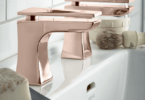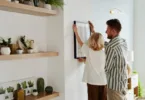Smart home security systems can certainly make your life easier, but you might be wondering what exactly they can do for you? In other words, what is home automation all about? As the name suggests, a home automation system automates many aspects of your day-to-day life at home. As a result, you can tailor your smart home to your needs, choosing as many elements as you like. In addition, an automated home security system is a great way to make your life safer, from smart lighting to smart locks.
What Can My Smart Home Security System Do?
The possibilities are endless with a smart security system! But, of course, it all depends on the individual devices you choose to add to your system. So here are some of the things your smart home can do.
Security Cameras
One of the main aspects of home security systems is security cameras. Depending on the layout of your home, you can position the cameras in any way you like to maximize security.
You can install outdoor cameras to monitor entries to your property and the garage. Or, a doorbell camera will let you see who is at the door without opening it.
Doorbell cameras are used remotely when you are away from home. Some have a two-way communication function, so you can speak to your visitor without being there! This is a great way to keep your home secure when you are at work or on vacation. You can even tell delivery drivers where to leave your parcels safely!
A video doorbell will generally connect to your existing doorbell wiring, so they are easy to install. And some will even replace the peephole, so you don’t need to drill a hole in the door. Some models also come with or connect to other smart cameras. It’s possible to find bundles containing both indoor cameras and outdoor cameras for video doorbells.
A good security camera will offer a high-resolution live video feed that is viewed and stored on other devices, like smartphones.
Many will also have a motion detection feature. This means the surveillance cameras aren’t recording constantly; instead, they only kick in when the motion sensors are activated. If your camera is connected to your phone, you will be alerted when there is movement outside your property.
Smart Lighting
Leaving a lamp on to make it look like someone is home has long been a preferred home security measure.
But, this can unnecessarily increase your energy consumption. We all know that wasting energy is bad for the environment. Still, energy costs have increased exponentially recently, so why not invest in smart lights to make things easier and cheaper?
Smart bulbs are straightforward to install and can be used in most of your existing lighting – replace your light bulbs with dedicated smart bulbs.
Like pretty much every other aspect of your smart home, smart lights turn on and off using smartphones. So, you can turn the lights on before going up or down the stairs when it is dark or a few minutes before arriving home in winter. And, instead of leaving all the lights on when you’re on vacation, you can switch different ones on throughout the day to ensure the house looks occupied without wasting energy.
Smart Door Locks
Do you often find yourself wondering whether or not you locked the front door after leaving the house? Then smart locks could be the perfect addition to your self monitored home security system.
Each smart lock has its unique features, and, like most things, you get what you pay for. So, if you are willing to splash out, you’ll find some incredible features. For example, even the most basic models will allow you to lock and unlock the door using your phone. No more rummaging around for keys in the bottom of your bag!
If you choose a higher-end model, not only will you be able to unlock doors using your smartphone, but you might also be able to link the system to other smart devices such as voice assistants. So, you won’t even have to pick up your phone to unlock the door!
Depending on which model you choose, you might also be able to grant access to family and friends. This is handy if someone checks on the house and perhaps the pets when you are on vacation.
A Bluetooth smart lock requires you to be within a close range of the door to control it, whereas a Wi-Fi door lock can be controlled from just about anywhere in the world – you don’t have to be on your home Wi-Fi network to use it.
Your garage door can also be controlled thanks to smart garage door openers, which is an excellent addition to smart security systems.
These handy gadgets will integrate with your home automation system, allowing you to remotely open and close the garage. And, you can do things like set the garage door to lock when the front door locks or turn the lights on in the house when the garage door is opened, so everything is ready the moment you pull up in the driveway. You can also set the system to give you a notification when the door is open, so you won’t accidentally leave it ajar when heading out.
Window sensors are another option for improving your home’s security. Some home security providers offer these as part of an alarm system, and they are ideal for stopping intruders from gaining access to your property through the windows. In addition, some will sound an alarm when the window is broken or when it is forced open, so you will be alerted before further damage occurs.
Smart Plugs and Smart Switches
Can’t afford to upgrade all your devices and appliances to smart ones? Then a smart plug is just what you need! These nifty gadgets allow you to control any device plugged into them using a mobile app or through smart speakers, using your voice.
They are effortless to install and will allow you to automate even more aspects of your day-to-day life! All you have to do is plug the adapter into a power outlet, then plug your appliance into the smart socket. Some smart plugs only have one outlet, while others have a line of four or six, allowing you to automate even more gadgets.
Not all of these products work in the same way – they each have their own unique features. However, you’ll be able to do things like set appliances to turn on at particular times to make it look like someone is at home when you’re away on vacation. So, these plugs are ideal from a home security perspective.
Or, you can set heaters to come on when the temperature drops below a certain level or lights to come on at particular times based on when the sun rises and sets.
Not only can your devices be controlled remotely with these plugs, but they can also be used to monitor energy efficiency. For example, some will tell you how many hours the connected device has been used for, while others will estimate how much it costs to run the device.
Smart Smoke Detectors
No home should be without a smoke alarm, but did you know they can also be integrated with your smart home automation system?
Smart smoke alarms connect to the internet so they can give you alerts about any potential issues, even when you are away from home. Some even can pinpoint the exact location of a fire in the home.
We all know smoke alarms can go off accidentally sometimes, usually thanks to burning toast! With a smart fire alarm, you won’t need to wave a towel around to silence false alarms – there’s a handy feature for that within the app, instead. Some also have carbon monoxide detectors built-in.
Smart Thermostats
The final thing you might like to add to your smart home is a smart thermostat – made famous by Nest. Nowadays, there’s much more choice for smart thermostats, and they are very popular for a good reason.
A smart thermostat is a significant first step if you’re looking to get started in home automation. Like most technology, the more expensive, the more features it will tend to have. However, even the most basic smart thermostats can make your life a lot simpler.
You can use the device to adjust the temperature of the heating throughout the house instantly. In addition, you can make a schedule of when the heating should come on and off, so you can ensure the house will always be warm when you get home from work in the winter. And, you can manually override it if something unexpected causes your routine to change.
Some of these devices go further and don’t just help you heat your home but also detect unusually high or low humidity levels. Like many aspects of home automation, these thermostats can usually be controlled using apps or a compatible smart speaker like a Google Assistant or Amazon Echo.
What Are The Advantages And Disadvantages Of Smart Home Security Systems
While smart home technology is undeniably beneficial and convenient for the modern lifestyle, it can also true that it has its drawbacks. Let’s take a look at both sides of the argument below.
Smart Home Automation Advantages
Convenient
Arguably the biggest advantage of a smart home system is the convenience it gives those with busy lifestyles. With apps and voice control options, you don’t even have to reach for remote control to activate your devices! And, the more connected devices (and you can see above, there are plenty you can add), the more convenient your life can become!
With home automation, you can even control devices remotely away from home. So, you can have everything ready for when you get in or keep things running when you are on vacation for safety.
Save money on energy
As well as giving you remote access to many aspects of your home, you might also find you can enjoy energy savings with smart home products. For example, you can easily monitor heating costs by using a smart thermostat, and smart plugs will ensure your devices are only on when you need them to be.
Increase safety
A smart home security system will ensure you and your loved ones are always protected against intruders with or without a security system. Cameras can help you monitor all entry points to your home, and with a mobile app, you can even do this when you are out at work.
Smart Home Automation Disadvantages
High initial costs
Unfortunately, smart home security systems and home automation devices don’t always come cheap. Depending on the brand you choose and the features you are looking for, you might find the entire system can run into thousands.
Monthly subscription fees
On top of the initial costs of purchasing the gadgets, some services will require a subscription fee to be paid every month for things like cloud storage or professional monitoring.
Can be complex
Some devices can be challenging to set up, especially if you want to create an interlinked system with many components. In some cases, professional installation may be the best option. But, again, this can be costly.
Devices may not connect to each other
Even with Wi-Fi connectivity becoming increasingly common, you might find some of your devices don’t ‘communicate’ with one another. This is especially apparent if they are different brands. So, you might find it easier to stick to one brand, like Samsung SmartThings.
Similarly, none of your devices will work if the internet goes down or, even worse, there is a power outage! Even battery-powered devices won’t work in an outage, thanks to the lack of Wi-Fi.
Possible privacy concerns
One of the biggest worries people have about a smart home is privacy. As with any smart device that is connected to the internet, there is the chance of hacking. However, by following some simple steps discussed in detail in the following section, you can significantly minimize the chances of hacking or data breaches.














